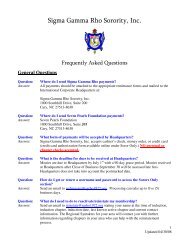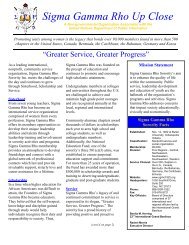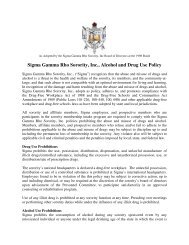They Stood Alone - Sigma Gamma Rho Sorority, Inc.
They Stood Alone - Sigma Gamma Rho Sorority, Inc.
They Stood Alone - Sigma Gamma Rho Sorority, Inc.
- No tags were found...
Create successful ePaper yourself
Turn your PDF publications into a flip-book with our unique Google optimized e-Paper software.
Exercising Stock OptionsCompanies offer employee stock options for two main reasons. First, money paid by employees topurchase shares goes directly into the company’s coffers. Second, stock options can be an enticingemployee benefit. If the exercise price of the option is lower than the company’s fair market price atthe time of purchase, employees are free to sell and make an immediate profit — or hold the stockin hopes of a higher profit in the future.Employees can purchase their stock options in three ways:• Same-day sale. This is also known as a “cashless exercise.” The employee arranges to sellshares immediately after they are acquired. Money to exercise the stock options is actuallyborrowed from the brokerage firm, but the loan is quickly repaid using proceeds from the saleof the stock. Same-day sales often are made to “lock in” a profit resulting from a significantdisparity between the exercise price and the current fair market value.• Cash exercise. In this scenario, the employee uses his or her own money to pay for shares,and then either holds or sells the shares.• Sell-to-hold. An employee may opt to sell some of the shares to pay for the purchase. Ofcourse, this strategy only works if the underlying stock has appreciated, thus creating a largecapital gain upon exercise. For example, an employee could buy 500 shares of stock at $10per share, immediately sell 200 shares at a $25 market price to pay the bill, and then hold theremaining 300 shares.Ask QuestionsThere is another factor that employees should consider before exercising a right to buy theircompany’s shares. As with company-sponsored retirement plans like a 401(k), it can be easy forworkers to acquire a significant amount of their employer’s stock. But in some cases, those holdingscould come to represent a disproportionate share of the worker’s entire stock portfolio.While individual circumstances vary, many experts agree that it is too risky to place more than about10 percent of a portfolio in the stock of any one company, even your own. Of course, employeesmight feel that their close association with their company gives them a “heads up” on its prospects.Still, putting too many financial eggs in one basket is not a sound investment strategy.Wachovia Securities is not a legal or tax advisor. However, we as FinancialAdvisors will be glad to work with your accountant, tax advisor and/orattorney to help you meet your goals. Past performance is no guarantee offuture results.This article is provided by courtesy of Lillie M. Hibbler-Britt, AssociateVice-President Investments with Wachovia Securities in Charlotte, NC. Lilliewelcomes your comments, and you can reach her at 704-348-9575 or 877-819-5270. The accuracy and completeness of this article are not guaranteed. Theopinions expressed are those of the author(s) and are not necessarily thoseof Wachovia Securities or its affiliates. The material is distributed solely forinformation purposes and is not a solicitation of an offer to buy any securityor instrument or to participate in any trading strategy. Wachovia Securities,LLC, Member New York Stock Exchange and SIPC, is a separate nonbankaffiliate of Wachovia Corporation. ©2006 Wachovia Securities, LLC.Investments in securities and insurance products: NOT FDIC-INSURED/NOTBANK-GUARANTEED/MAY LOSE VALUE24

















